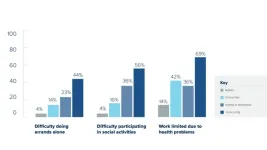Perfluoroalkyl and polyfluoroalkyl substances (PFAS), also known as ‘forever chemicals’ which make surfaces resist stains, water and grease, are man-made chemicals extremely persistent in the environment and in our bodies. These chemicals are considered endocrine disruptive, meaning they interfere with the body’s hormones and could have harmful effects on puberty and childhood development. PFAS have previously been associated with reduced fertility, thyroid disease, and obesity.
In this study, Dr Ingvild Halsør Forthun and colleagues in Norway analysed 19 different PFAS chemicals in 420 boys and 618 girls aged 6-16 years, as part of the Bergen Growth Study 2. They also measured the children’s breast development and testicular size using ultrasound, and found that boys had smaller testicles while girls had less advanced breast development when they were exposed to higher levels of a number of PFAS chemicals.
Previous studies have also shown the same association between PFAS chemicals and later puberty. However, up until now, information on pubertal development was mostly self-reported. “This is the first study exploring the link between PFAS exposure and pubertal development using ultrasound as a novel and more objective method,” said lead author Dr Forthun, a PhD candidate at the Haukeland University Hospital in Bergen. “Our findings could contribute to the national and international regulatory decisions authorities make about these chemicals.”
The team is now planning to investigate how hormones involved in puberty and body composition are associated with PFAS levels within the Norwegian child population. “Our findings provide further evidence for the harmful effects of PFAS on childhood development, but it is still unclear how these chemicals impact puberty-related hormones and body composition in children. This could shed light on reproductive issues and contribute to better regulation making” says Dr Forthun.
--------ENDS-------
RFC6.3
Exposure to Per- and Polyfluoroalkyl Substances and Pubertal Assessment by Ultrasound in Norwegian Boys and Girls: Data from the Bergen Growth Study 2
Ingvild Halsør Forthun1,2, Mathieu Roelants3, Line Småstuen Haug4,5, Helle Katrine Knutsen4,5, Ingvild Særvold Bruserud1,6, Petur Benedikt Juliusson2,1,7
1Children and Youth Clinic, Haukeland University Hospital, Bergen, Norway. 2Department of Clinical Science, University of Bergen, Bergen, Norway. 3Department of Public Health and Primary Care, Centre for Environment and Health KU Leuven, Leuven, Belgium. 4Department of Food Safety, Norwegian Institute of Public Health, Oslo, Norway. 5Center for Sustainable Diets, Norwegian Institute of Public Health, Oslo, Norway. 6Faculty of Health, VID Specialized University, Bergen, Norway. 7Department of Health Registry Research and Development, Norwegian Institute of Public Health, Bergen, Norway
Abstract
Background and aim: Per- and polyfluoroalkyl substances (PFAS) are a group of synthetic chemicals found in everyday consumer products. These chemicals are considered endocrine disruptive. However, their effect on pubertal onset and development is still unclear. The aim of the current study was therefore to explore the relationship between PFAS exposure and pubertal development using novel objective pubertal phenotyping, e.g., ultrasound-determined testicular volume and ultrasound-based breast staging collected in the Bergen Growth Study 2 (BGS2).
Material and methods: BGS2, conducted in 2016, was the first Norwegian pubertal reference study. Pubertal status was assessed with Tanner staging and ultrasound measurements in a cross-sectional sample of 301 boys and 200 girls (8-16 years). In addition, serum samples were analyzed for 19 different PFAS. Testicular volume-for-age z-scores were calculated for boys, and girls were classified as early (n= 32), average (n= 106), or late maturing (n= 62) based on ultrasound-measured breast development-for-age percentiles. To examine the associations between PFAS levels and age-adjusted degree of pubertal development, linear regression and logistic regression analysis were applied in boys and girls, respectively, and adjusted for age, height and educational level of parents.
Results: Perfluorooctanoic acid (PFOA), perfluorononaoic acid (PFNA), perfluorodecanoic acid (PFDA), perfluorohexanesulfonic acid (PFHxS) and perfluorooctanesulfonic acid (PFOS) were included in the analyzes as all had more than 90% of the samples above the limit of quantification. Boys with higher levels of PFNA (estimated beta coefficient (β), -0.14, 95% confidence interval [CI], -0.62 to 0.03) and PFOS (β, -0.17, 95%CI, -0.19 to -0.01) were more likely to be late maturing. In girls, higher levels of PFOA were associated with a reduced odds of being early compared to average and late maturing (OR: 0.13, 95%CI: 0.02, 0.89), and higher levels of PFNA was associated with an increased odds of being late compared to early and average maturing (OR: 3.14, 95%CI: 1.17, 8.43). No other associations were significant at a 0.05 level.
Conclusions: Higher levels of PFAS were associated with being late maturing in both sexes based on age-adjusted ultrasound puberty scores.
Notes for Editors:
For press enquiries, or to arrange an interview with the study authors, please contact the ESPE 2023 press office:
Joanna Williams
Communications Executive
Mob: +44 (0) 7876 842 027
Email: joanna.williams@endocrinology.org
The study “Exposure to Per- and Polyfluoroalkyl Substances and Pubertal Assessment by Ultrasound in Norwegian Boys and Girls: Data from the Bergen Growth Study 2” will be presented on Friday 22 September 2023 at the 61st Annual Meeting of the European Society for Paediatric Endocrinology (ESPE 2023) at the World Forum in The Hague, Netherlands.
The 61st Annual Meeting of the European Society for Paediatric Endocrinology is held at the World Forum in The Hague, Netherlands, on 21-23 September 2023. This year's theme is “Global Challenges in Paediatric Endocrinology”. See the full scientific programme here.
The European Society for Paediatric Endocrinology (ESPE) is a truly international organisation aiming to improve the clinical care of children and adolescents with endocrine conditions, including diabetes, through research and education. END




